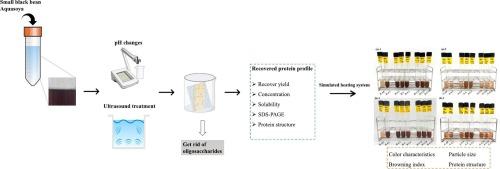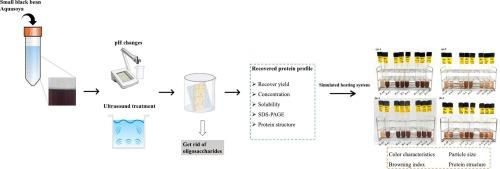优化水产蛋白:各种预处理方法对提高小黑豆副产品再循环潜力的启示
IF 8.5
1区 农林科学
Q1 CHEMISTRY, APPLIED
引用次数: 0
摘要
为了最大限度地减少资源浪费和促进循环利用,必须从副产品中回收营养成分。本研究旨在优化从小粒黑豆副产品中回收 Aquasoya 蛋白质 (AS-P),重点研究 pH 值调节、超声处理和分馏对蛋白质产量、溶解度和结构完整性的影响。pH 值为 8.5 的碱性处理显著提高了 AS-P 的回收率(77.60%)和蛋白质浓度(421.16 μg/mL),这归因于溶解度的提高和非蛋白质成分的有效去除。分馏后,超声处理 10 分钟的蛋白质溶解度最高(88.69%),表明蛋白质聚集减少。分馏对于减少褐变反应和通过去除低聚糖和杂质提高蛋白质纯度至关重要。SDS-PAGE 分析显示碱性处理产生了明显的蛋白质条带,而超声处理则导致脂氧合酶 (LOX) 蛋白质降解。主成分分析(PCA)表明,分馏显著提高了 AS-P 的稳定性和质量,使其成为一种可用于食品的成分。本文章由计算机程序翻译,如有差异,请以英文原文为准。


Optimizing aquasoya protein: Insights of various pre-treatments for enhancing the upcycling potential from small black bean by-product
To minimize resource waste and promote recycling, it is essential to recover nutritional components from by-products. This study aimed to optimize of Aquasoya protein (AS-P) recovery from small black bean by-products, focusing on the effects of pH adjustments, sonication, and fractionation on protein yield, solubility, and structural integrity. Alkaline treatment at pH 8.5 significantly enhanced AS-P recovery yield (77.60 %) and protein concentration (421.16 μg/mL), attributed to the increased solubility and effective removal of non-protein components. Sonication for 10 min exhibited the highest protein solubility (88.69 %) post-fractionation, indicating reduced protein aggregation. Fractionation was crucial in minimizing browning reactions and enhancing protein purity by eliminating oligosaccharides and impurities. SDS-PAGE analysis revealed distinct protein bands from alkaline treatment, while sonication resulted in lipoxygenase (LOX) protein degradation. Principal Component Analysis (PCA) emphasized that fractionation notably enhances the stability and quality of AS-P, making it as a viable ingredient for food applications.
求助全文
通过发布文献求助,成功后即可免费获取论文全文。
去求助
来源期刊

Food Chemistry
工程技术-食品科技
CiteScore
16.30
自引率
10.20%
发文量
3130
审稿时长
122 days
期刊介绍:
Food Chemistry publishes original research papers dealing with the advancement of the chemistry and biochemistry of foods or the analytical methods/ approach used. All papers should focus on the novelty of the research carried out.
 求助内容:
求助内容: 应助结果提醒方式:
应助结果提醒方式:


